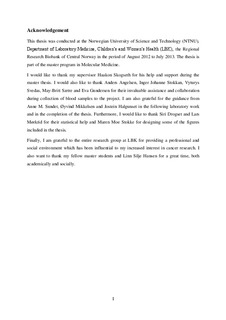The serum levels of suPAR in benign prostate hyperplasia and prostate cancer - a comparative study
Master thesis
Permanent lenke
http://hdl.handle.net/11250/263921Utgivelsesdato
2013Metadata
Vis full innførselSamlinger
Sammendrag
The plasminogen activator system is assumed to play a key role in the degradation of extracellular matrix and basement membranes. During cancer invasion and metastasis, the activated plasminogen activator system cleaves plasminogen to the active plasmin. Plasmin is able to degrade a wide range of extracellular matrix proteins either directly or indirectly by activation of additional proteolytic enzymes.
Accumulating evidence has shown that the urokinase plasminogen activator system might be upregulated in many types of malignancies, including prostate cancer. Previous studies have found an association between the soluble form of the urokinase plasminogen receptor, abbreviated as suPAR, and the development and progression of prostate cancer. Furthermore, it has been proposed that the quantification of suPAR in serum might serve as a useful adjunct to current conventional diagnostic tools.
Published literature is limited regarding both the suPAR levels in patients diagnosed with benign prostate hyperplasia (BPH) and the differences in suPAR concentration between BPHand prostate cancer patients. In the present thesis, the serum levels of suPAR in BPH- and prostate cancer patients are therefore quantified to determine whether there is a statistically significant difference between the two groups.
The present thesis concludes that there is no statistically significant difference in the suPAR concentration between BPH patients (median 0.22 ng/mL) and prostate cancer patients (median 0.17 ng/mL). However, methodological limitations of the immunoassay utilized for suPAR quantification was encountered, and further studies are warranted to give an exact estimation of the suPAR concentration in BPH- and prostate cancer patients. In addition, due to limited published literature, it was difficult to define the normal or abnormal levels of suPAR.
The serum samples obtained in the present thesis are stored at the Regional Research Biobank of Central Norway and are accessible for future studies. By including samples from the HUNT research biobank, it might be achievable to obtain a larger cohort of serum samples and further investigate the role of suPAR as a predictor of prostate cancer progression.
